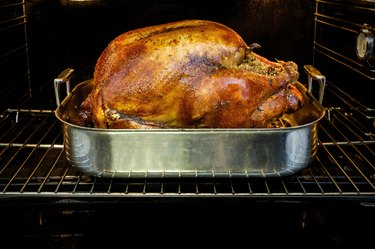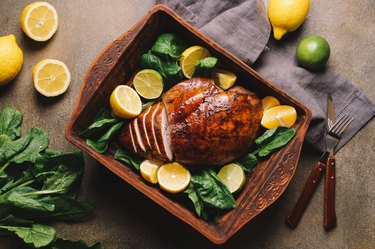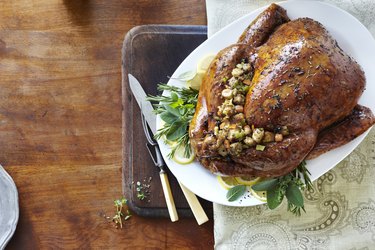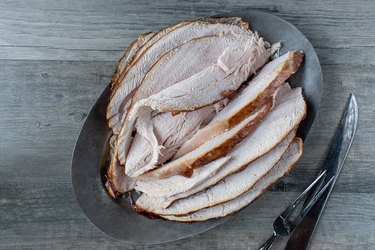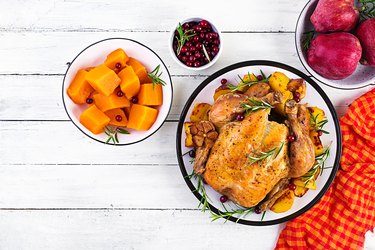
When it comes to cooking a 19-pound turkey, you have many options. You can smoke, grill, air fry, deep fry or slow cook your bird. You also have the choice of deconstructing it and roasting the parts. But the classic way to cook a large turkey is to roast the whole bird in the oven.
Prepping Your Turkey
Video of the Day
If you purchased a frozen unstuffed turkey, the Centers for Disease Control and Prevention recommends thawing it in one of three different ways before cooking: in the refrigerator, in cold water or in the microwave. If thawing in the refrigerator, keep your bird in the original wrapping and place on a pan to catch any juices. Thawing a 19-pound turkey in the fridge will take about five days, according to the USDA Food Safety and Inspection Service.
Video of the Day
Thawing your turkey in cold water is a quicker process: It will take about 10 hours for a 19-pound turkey to defrost. First, wrap your turkey securely to ensure no water seeps in and submerge in cold tap water, which you should change every 30 minutes. For thawing in the microwave, remove all wrapping from your turkey, place it in a microwave-safe dish to catch any juices and follow your microwave's user manual for exact thawing times and power levels.
Once your turkey is thawed, you are ready to roast. According to the University of Tennessee Institute of Agriculture, you should place your turkey breast-side-up on a metal rack in a shallow roasting pan. If you'd like, you can place a loose tent of aluminum foil over the turkey for the first one to 1 1/2 hours of roasting time to prevent the turkey from browning too much.
Turkey Cooking Time Per Pound
In an oven set to 325 degrees Fahrenheit, cooking an 18- to 20-pound unstuffed thawed or fresh turkey will take between 4 1/4 and 4 1/2 hours, according to the USDA. This amounts to about 14 minutes of cooking time per pound. For a 19-pound turkey, this comes to about four hours and 26 minutes. Stuffing your turkey will increase the cooking time.
Turkey roasting times vary depending on whether you are using a gas or electric oven, when it was built and whether the temperature has been correctly calibrated. This means that you can use the clock as a gauge for roasting your bird, but you shouldn't completely rely on it to ensure that the meat is fully cooked. When roasting turkey in the oven, there is a tool that is even more important than a timer: a meat thermometer.
According to the USDA, your turkey is safe to eat when the internal temperature has reached at least 165 Fahrenheit. To measure the temperature of your turkey with a meat thermometer, insert the tool into three distinct parts of the bird: the innermost part of the thigh, the innermost part of the wing and the thickest part of the breast. Do this even if your turkey comes with a pop-up thermometer.
Brining Your Turkey
If you have the time and kitchen space, you can add flavor to your turkey by brining it before cooking. According to the Auguste Escoffier School of Culinary Arts, soaking in a brine made up of salt, water and other ingredients like herbs and spices can help your turkey retain moisture and make it more tender. You'll need to clear enough space in your fridge for your turkey and the container it'll be submerged in and allow 24 to 48 hours for your bird to soak.
Take note: If your turkey is labelled "kosher" or "enhanced," you shouldn't brine it. This means it has already been treated with salt, so brining would result in a bird that is too salty. If you choose to brine, you will need to wash the brine off your turkey before cooking. When washing your bird, ensure you have all dishes and utensils out of the way to prevent cross contamination.
- USDA Food Safety and Inspection Service: "Let's Talk Turkey—A Consumer Guide to Safely Roasting a Turkey"
- Centers for Disease Control and Prevention: "Food Safety Tips for Your Holiday Turkey"
- University of Tennessee Institute of Agriculture: "Take the Guesswork out of Roasting a Turkey"
- Auguste Escoffier School of Culinary Arts: "To Brine or Not to Brine?"
